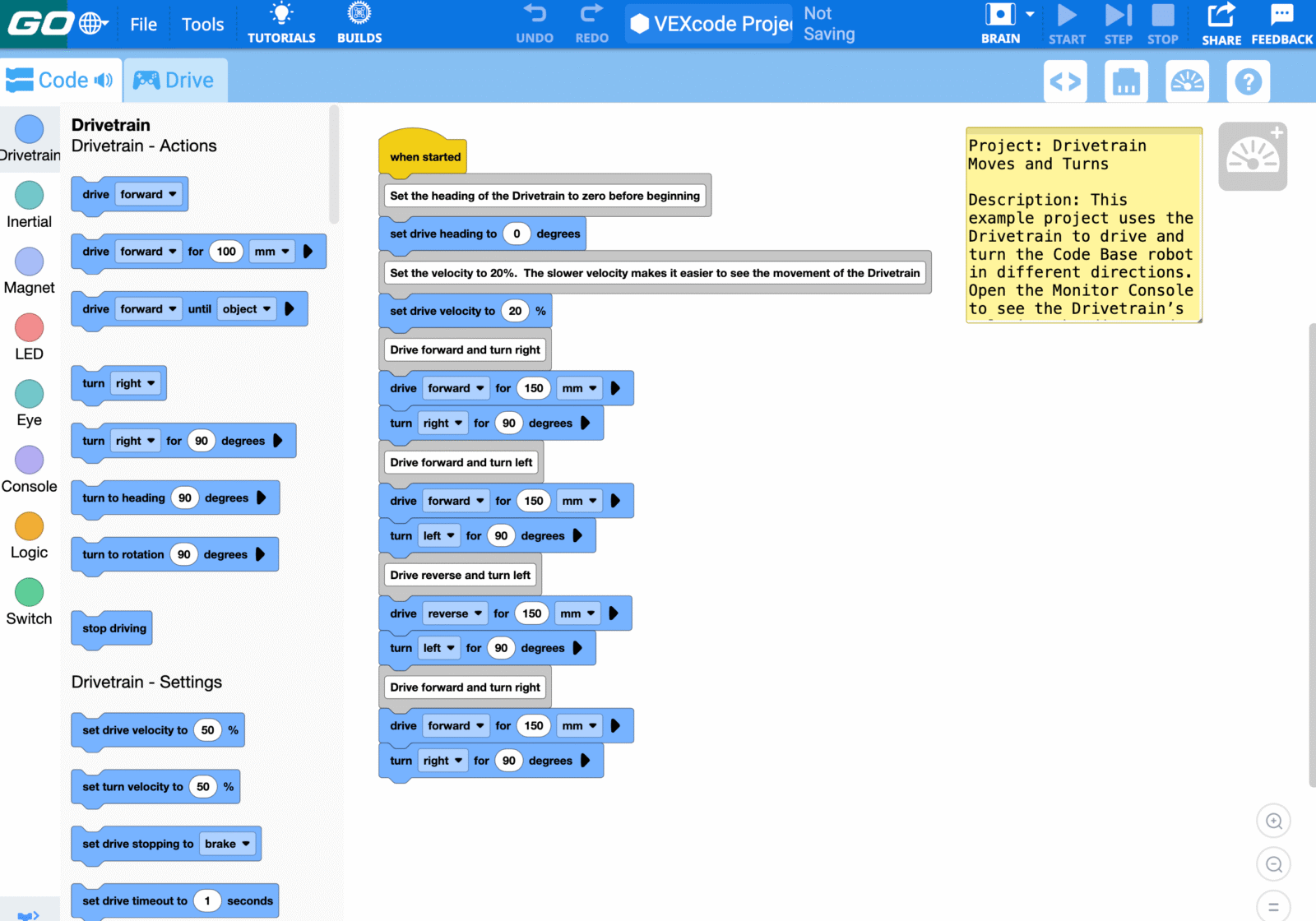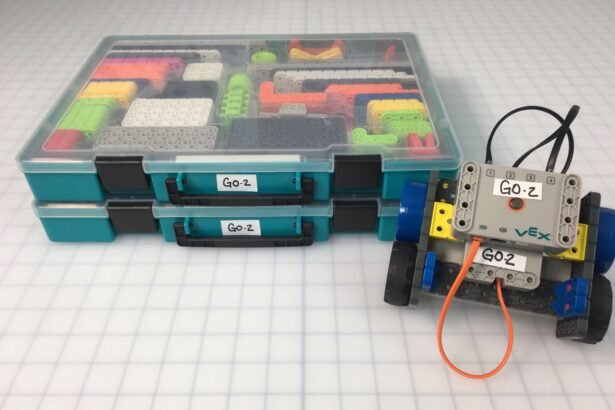VEX Robotics in the classroom helps children learn by building small machines and telling them what to do with simple code. It looks like hands-on science time, not a special effects studio. The tools are real, the goals are clear, and the steps are small enough for young learners.
A tiny chassis wiggles. Two first graders press a go button as if it were a launch. The robot rolls to a taped square, pauses, turns, and stops where they planned. Smiles ripple around the table, and quiet cheers follow.
This is what early STEM looks like in motion. Plan, build, try, laugh, tweak, and try again. VEX turns that energy into a simple routine that fits real classrooms and real time limits.
What is VEX Robotics?
VEX is a classroom-ready system for K through 12. Students get sturdy kits with parts that click or fasten together, a coding app called VEXcode, and free lesson plans called STEM Labs. The materials are designed to adapt, so schools can adjust activities to fit local goals and schedules.
Kids snap parts together in class, add motors and simple sensors, and write short programs to make robots move and react. Younger grades use plastic parts that are easy to handle, while older grades use metal for stronger builds. The idea stays the same while the tools grow.
VEXcode looks and feels the same across levels. Beginners use drag-and-drop Blocks that fit together like puzzle pieces. When ready, students switch to Python or C++ in the very same app and can even convert a Blocks project to text with a click. VEXcode runs on Chromebooks, iPads, Windows, Mac, and Android.
Teachers are supported. STEM Labs provide step-by-step lessons with clear goals, pictures, and simple checks for understanding. The VEX Library offers how-to guides and troubleshooting. Many teachers start with a small set of lessons and then adjust timing, parts, and prompts to match their students. The routine stays the same while the details flex.
If you’ve seen LEGO® kits in school, VEX may feel familiar. Here’s how they compare at a glance.
VEX vs LEGO®: A Friendly Comparison
If your child has built with LEGO®, using VEX will feel familiar. Both invite hands-on building, quick tests, and small adjustments that lead to a better result. VEX parts snap or fasten to make small machines. Students follow pictures at first, then begin to tinker. A small change, like moving a wheel or adding a gear, changes how the robot behaves.
Coding also feels familiar to many families. VEXcode Blocks uses colorful command blocks that read like plain language. Move forward, turn right, wait, and repeat. Kids drag blocks into order, press run, and watch the robot act out the plan. As students get older, VEX keeps the same basic look and feel, so moving from blocks to text happens without starting over in a new app.
Where VEX stands out is the clear path as children grow. The same coding environment runs from the first try in the early grades to more advanced work in middle and high school. Classrooms can start at the level that fits today and add more later. Competitions exist for schools that want them, but regular classes work well without them. The core routine is useful on its own.
With that in mind, let’s zoom in on what your child does with VEX in class.
What Kids Actually Do?
Students build a small robot, code a few simple commands, and test on the floor or a mat. Tape lines and marked squares make goals clear. A typical challenge is to drive to the square, turn, and stop inside it. Another is to follow a line or nudge a soft block into a goal area. These are quick, doable tasks that fit a class period.
Sensors make it more interesting. A distance sensor can stop the robot before it bumps into something. A bumper switch can tell the program to try a different path. A simple gyro can help with straighter turns. Kids learn that sensors are like the robot’s eyes and fingertips.
Teamwork stays simple and fair. Groups of two or three rotate jobs such as builder, coder, and tester. A short sentence frame such as We changed ___ because ___ helps students put thinking into words and gives teachers a quick window into the team’s logic.
Now that the hands-on loop is clear, here is how a single class usually runs from start to finish.
Inside a Typical Class
The teacher sets a short challenge, such as driving to a square and stopping. Teams check the robot, write a short program, and run a test. The goal is to learn from each run, not to get it perfect on the first try.
During the middle of class, your child fine-tunes the robot by changing one thing at a time and testing right away. If the robot went too far, your child lowers the speed or shortens the time. If a turn was wide, they adjust the angle or move a wheel one notch. The rule is one change, one test, then notice the result. That simple rhythm makes cause and effect easy to see.
At the end of class, each team shares one run and one reason for a change. Your child might say, “We lowered the speed so it would stop inside the square.” The teacher invites a question or two, celebrates effort and progress, and everyone resets the space. Parts go into labeled trays, devices are plugged in, and the mat is ready for the next group.
All of this fits in a 40 to 50-minute class. The steps are simple, and the habits are powerful. Here is why the routine works in real classrooms.
Why VEX Robotics in the Classroom Works
Thinking is visible. When students build and code a small robot, their thinking shows on the table and floor. A run that goes too far or turns too little is easy to see. That makes feedback clear and calm.
Mistakes become data. Each try gives one new clue. Students change one thing, try again, and watch for a better result. The cycle is quick and low stress, so persistence feels natural rather than forced.
Teamwork stays simple. Pairs or trios rotate jobs such as builder, coder, and tester. Everyone can explain what changed and why. Talk becomes part of the learning, not an extra step.
Confidence grows in small steps. Kids see cause and effect in minutes, not weeks. A tiny win, like stopping inside a taped square, builds the nerve to tackle the next goal.
Skills carry into other classes. Measuring distance and time supports math sense. Angles, speed, and light relate to science topics. Writing short design notes strengthens clear sentences and useful vocabulary.
The basic pattern of build, code, test, and improve stays the same as parts and projects get more advanced. Students keep familiar habits while their tools become more capable.
With the class routine in view, here is how the coding works, from simple blocks to text, without switching apps.
How the coding works
Your child will use one app called VEXcode. It looks the same from the early grades through high school, so there is no new program to learn each year. Familiar screens and buttons keep the focus on ideas, not on hunting for menus.
Most children start with block-based coding. The commands look like puzzle pieces that snap together. This helps kids think through the plan without worrying about typing. Many families will recognize the style because it looks similar to Scratch from MIT. Your child drags blocks into order, presses run, and watches the robot follow the steps.
When ready, your child can try typing real code in the same app. VEXcode supports languages such as Python and C++. There is even a button that shows the text version of a Blocks project, so kids can see how the two match. The switch feels like a natural next step, not a restart.
The core ideas stay the same as your child grows. Repeat a set of steps. Start an action when a button is pressed. Remember a number, such as a distance or a speed. Use sensors like eyes and fingertips so the robot can notice the world.
Bottom line: your child plans the steps, clicks together a few blocks, presses run, watches what happens, and makes one small change for the next try.

What Parents Will Notice at Home
You may hear new words at the dinner table. Children talk about sensors, gears, and angles, and they use numbers for distance and time. This is a good sign that they are connecting words to actions.
You will see careful observation. Many students learn to pause and watch the whole run before changing anything. They notice when the robot goes a little too far, or turns a little too much, and they can say what to try next.
Small wins feel big. Getting the robot to stop inside a taped square is a clear success. These quick wins build confidence and make students eager to try the next challenge.
Frustration tends to shrink. When a run does not work, students are taught to change one thing and test again. The loop turns mistakes into information, and the tone at home often becomes calmer as well.
You may notice clearer explanations. Simple prompts like “We changed ___ because ___” help students put thinking into words. Over time, they give shorter, sharper answers about what they did and why.
With those home changes in mind, here are clear answers to the questions families ask most often.
Simple Answers to Common Questions
Is VEX safe for my child at school?
Yes. Classroom kits use parts sized for small hands and rounded where they matter. Early levels rely on clip or snap connections. Older levels introduce sturdier pieces and simple tools under teacher guidance. Classes set clear rules for moving robots, sharing parts, and cleaning up.
How much screen time will my child have with VEX?
Coding happens in short bursts. Most minutes go to building, testing on the floor, and talking about what changed. Screens come out to write a few commands, then go away so students can watch the result and make a small adjustment.
Does a child need strong math to start with VEX?
No. Robotics helps math make sense. Students measure distance, set speeds, and adjust angles to meet a goal. Numbers are tied to action, so ideas like “quarter turn” or “30 centimeters” become concrete.
Do students have to join VEX competitions?
No. VEX competitions are available for schools that want the extra spark, but regular classes work well without them. Many programs stay inside the school day with short, in-class challenges.
What does a school need to run VEX in class?
A grade-appropriate VEX classroom kit, a shared device with VEXcode, a bit of floor space with tape lines or a small mat, and a few printed STEM Lab lessons. That is enough for students to build, code, test, and improve within a single period.
Summary
Robotics becomes a simple routine. Students build a little, code a little, test, and improve. Everything fits in a normal class period, and progress shows up in small wins. If LEGO® time has been part of school, VEX will feel familiar. Parts snap or fasten, students tinker and test, and coding starts with blocks.
VEX Robotics in the classroom gives schools a practical way to teach hands-on science and coding. Kits, VEXcode, and ready lessons form a complete package that teachers can adapt to local goals and schedules. The path continues from early grades through high school without switching to a brand new app each year. Students learn to measure, adjust, and explain, and confidence grows one small success at a time.
LEGO® is a trademark of the LEGO Group, used here for comparison only; no endorsement implied.






